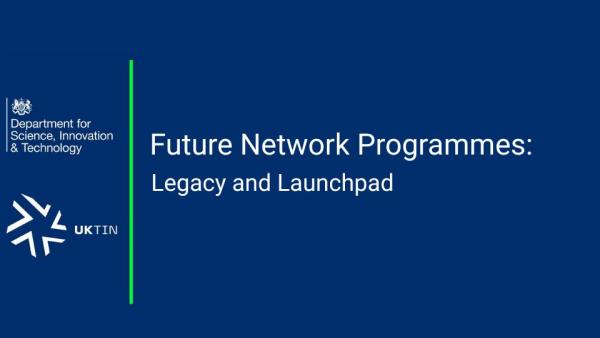
FRANC was the first intervention DSIT announced from the Open Networks Programme in 2021. A total of 14 projects were funded to support the goals of the Government’s 5G Supply Chain Diversification Strategy by helping to incentivise the industry to create new products and services to unlock the full potential of Open RAN.
These projects have enabled a wide range of organisations to focus on developing technical solutions such as:
• Radio transmitters
• Signal processing equipment
• Power management systems
• Software to support open interface architectures
The projects spread across the UK, including Glasgow, Cardiff, Cambridge, Newcastle, Newport, Slough and Ebbw Vale - building on the existing industrial strength of these regions, while further developing an engineering base with a new set of skills.
The projects are coming to a close this year, and we will be publishing a series of case studies and project closure reports to ensure that the broader ecosystem is able to benefit from the learnings and developments of each project .
In the latest in our FRANC case study series, we explore the CoMP-O-RAN project.
CoMP-O-RAN (Coordinated Multipoint Open Radio Access Network) Case Study
The CoMP-O-RAN project represents an advancement in telecommunications, leveraging cutting-edge British design and technology to address the challenges of deploying dense networks of small cells. A key innovation of this project is the use of integrated, easily commissioned, millimeter-wave (mmWave) fronthaul, which significantly reduces the need for disruptive street excavation typically required to connect every small cell with fibre optics. This approach not only streamlines the deployment process but also minimises the infrastructural and environmental impact.
In addition, the project adopts an OpenRAN architecture with Split 6, diverging from the more commonly used Split 7.2 interface between the Radio Unit (RU) and the Distributed Unit (DU). This strategic choice enables efficient operation despite the limited bandwidth of mmWave fronthaul compared to fiber, ensuring robust and reliable network performance.
A cornerstone of the CoMP-O-RAN project is the demonstration of Coordinated Multi-Point (CoMP) and Dynamic Point Selection (DPS) algorithms. These advanced algorithms are designed to minimise interference and maximise capacity and throughput, even in densely populated networks of small cells. By optimising network performance in this manner, the CoMP-O-RAN project showcases the potential for enhanced connectivity and improved user experiences in urban environments.
- DSIT funding: £4.7m
- Partner funding: £6.4m
- Project dates: 01/01/2022 - 30/09/2023
- Locations: Marlow, Bristol, Glasgow, Slough, London and DCMS Auto Air 5G Testbed at Millbrook Proving Ground, Bedfordshire
- Project Partners: Dense Air Limited (lead partner), Airspan Communications Limited, Blu Wireless UK Limited, Radisys UK Limited, University of Glasgow
Highlights and insights
The project achieved several groundbreaking milestones, pushing the boundaries of 5G technology:
- Revolutionary Open RAN Split 6 System: Developed an innovative fronthaul solution within an end-to-end Open RAN Split 6 system.
- Seamless Integration of Cutting-Edge Sub-Systems: Successfully combined technologies from Airspan, Radisys, and Blu Wireless, with Dense Air leading the system integration.
- Consortium-Led Innovation in Coordinated Multi-Point (CoMP): Implemented CoMP using the O-RAN Split 6 fronthaul, showcasing the power of collaborative technology.
- Dynamic Point Selection for Next-Gen 5G: Pioneered dynamic point selection for 5G SA, supported by current 5G UEs/handsets (3GPP Release 15).
- Breakthrough in mmWave Mesh Fronthaul Technology: Validated mmWave Mesh as a fronthaul technology, significantly reducing deployment operational and capital expenditures.
- Enhanced Small Cell Deployments with CoMP: Demonstrated the benefits of CoMP, delivering spatial diversity and multiplexing gains, improving capacity of small cell clusters over traditional macrocells, and showcasing energy/bit savings.
- State-of-the-Art Labs and Testbeds: Established advanced labs and testbeds including:
- The Marlow lab for consortium integration and manufacturing tests.
- The initial TV5G CoMP-O-RAN component testbed at Teesside International Airport.
- A permanent CoMP-O-RAN 5G testbed at Millbrook.
- Solid Foundations for Future Development: Laid the groundwork for further advancements in power optimization strategies, CapEx and OpEx optimization, and the development of commercial hardware and system solutions including a robust supply chain.
Next steps after the project funding period
- The CoMP-O-RAN project has made significant strides in developing and testing a network of prototypes, successfully proving the concept through this project's timescales.
- The successful implementation of the CoMP-O-RAN Small Cell network has demonstrated the effectiveness of the Split6/CoMP concept.
- Moving forward, the next steps involve optimising the design for cost-effective manufacturing, requiring a deeper level of integration than was possible within the initial project timeline.
- This promising concept will now transition into the Beach Project (funded through DSIT’s Open Network Ecosystem competition) which will focus on addressing future security aspects, refining software and interfaces, and strengthening the supply chain, paving the way for even more robust and innovative 5G solutions.









